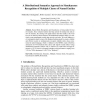Free Online Productivity Tools
i2Speak
i2Symbol
i2OCR
iTex2Img
iWeb2Print
iWeb2Shot
i2Type
iPdf2Split
iPdf2Merge
i2Bopomofo
i2Arabic
i2Style
i2Image
i2PDF
iLatex2Rtf
Sci2ools
CICLING
2010
Springer
2010
Springer
A Distributional Semantics Approach to Simultaneous Recognition of Multiple Classes of Named Entities
Named Entity Recognition and Classification is being studied for last two decades. Since semantic features take huge amount of training time and are slow in inference, the existing tools apply features and rules mainly at the word level or use lexicons. Recent advances in distributional semantics allow us to efficiently create paradigmatic models that encode word order. We used Sahlgren et al's permutation-based variant of the Random Indexing model to create a scalable and efficient system to simultaneously recognize multiple entity classes mentioned in natural language, which is validated on the GENIA corpus which has annotations for 46 biomedical entity classes and supports nested entities. Using distributional semantics features only, it achieves an overall micro-averaged Fmeasure of 67.3% based on fragment matching with performance ranging from 7.4% for "DNA substructure" to 80.7% for "Bioentity".
CICLING 2010 | Distributional Semantics | Entity Recognition | Natural Language Processing | Semantics |
| Added | 06 Dec 2010 |
| Updated | 06 Dec 2010 |
| Type | Conference |
| Year | 2010 |
| Where | CICLING |
| Authors | Siddhartha Jonnalagadda, Robert Leaman, Trevor Cohen, Graciela Gonzalez |
Comments (0)

